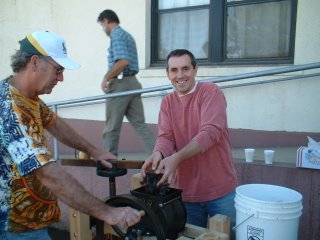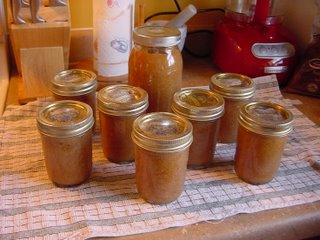Tools for Eating Local
 The impetus for this blog was to eat local as long as we can and to
The impetus for this blog was to eat local as long as we can and to chronicle our journey. Due to the fact that we are still safely ensconced in Suburbia growing our own food is a distant dream (though I am doubling our edible gardens next year) we will need help.
chronicle our journey. Due to the fact that we are still safely ensconced in Suburbia growing our own food is a distant dream (though I am doubling our edible gardens next year) we will need help.The biggest ally in our Quest for Local is the Madison, WI Farmers Market. The website is awesome, but can't really cover the feel of the Market on a bright August morning. Madison is flanked by 2 large
 lakes, so the air is crisp and clean, plus the University of Wisconsin: Madison is right down town and you are surrounded by the energy of youth and learning where ever you look. And then there is the beautiful State Capitol right in the middle of it all-with its classic archetecture, amazing rotunda, and organically maintained lawn planted from seeds from a Madison seed company.
lakes, so the air is crisp and clean, plus the University of Wisconsin: Madison is right down town and you are surrounded by the energy of youth and learning where ever you look. And then there is the beautiful State Capitol right in the middle of it all-with its classic archetecture, amazing rotunda, and organically maintained lawn planted from seeds from a Madison seed company.The headquarters of Organic Valley is located less than 100 miles to the northwest-and the name is legit. OV is the biggest employer and has revitalized an entire region of the state. Their Coop trucks thread thru the countryside picking up loads of milk, eggs, meat, and veggies from the farmers and give them very good prices for them while ensuring a regional market, and covering marketing and distribution issues. This ensures that there are dozens of organic growers within a few hours drive of Madison and the market is all the better for it.
The market is BIG -averaging 20,000 visitors a Saturday. This is on par with some large city festivals, the only difference is it happens every single week! Recent estimates of revenue are in the neighborhood of $200,000 per week. Considering it is really only going for about 5-6 hours that is amazing. Big Box retail will pull in that number on a Saturday, but it will take them from 8am to 10 pm to do it, and I don't see hundreds of grinning toddlers eating organic fruit at the them!
Still more local is going straight to the farm. My biggest resource for this is www.localharvest.com . First and foremost it will pinpoint farmer's markets, coops, and most importantly direct to consumer farms for whatever zip code you give it. Once you get the map to the size you want it you can click on any farm/market and get contact info and descriptions. Uber cool. The listings are by no means all inclusive-but you can use the first contact to springboard you into the local organic underground. Buy some eggs for the localharvest.com chicken farmer-and then ask them if they know of anyone that sells vegetables or fruit. They will and your then you're in!
The other huge piece on the local harvest site is its listings of CSA's.
 Community Supported Agriculture is to organic farming what GMO's are for Con Agra and can similarly revolutionize modern farming. Mia and I did a work share for Michael Field's CSA several summers ago and it was one of the pivotal moments of our lives. For the small sum of 5 hours 'work' (weeding, harvesting, and socializing) a week, we got a bushel of veggies and more organic gardening knowledge than you could fit in 10 books. Or we could have chosen to pay about $450 to pick up the veggies every week for a season. CSA's guarantee the farmer an income for growing veggies instead of Corn on Beans, encourage massive diversification of plantings (typically 6-12 varieties a week, every week, for 4 months), reconnect the consumer to the farm and make suburban farms viable. In Michael Pollan's book The Omnivore's Dilemma he talks with an Iowa corn farmer who would prefer to grow veggies, but laments that the Coop only buys corn and beans-who would he sell to? New Generation Marketing Coops like Organic Valley, and CSA's-at least near town centers- can answer that question. HUGE fan!
Community Supported Agriculture is to organic farming what GMO's are for Con Agra and can similarly revolutionize modern farming. Mia and I did a work share for Michael Field's CSA several summers ago and it was one of the pivotal moments of our lives. For the small sum of 5 hours 'work' (weeding, harvesting, and socializing) a week, we got a bushel of veggies and more organic gardening knowledge than you could fit in 10 books. Or we could have chosen to pay about $450 to pick up the veggies every week for a season. CSA's guarantee the farmer an income for growing veggies instead of Corn on Beans, encourage massive diversification of plantings (typically 6-12 varieties a week, every week, for 4 months), reconnect the consumer to the farm and make suburban farms viable. In Michael Pollan's book The Omnivore's Dilemma he talks with an Iowa corn farmer who would prefer to grow veggies, but laments that the Coop only buys corn and beans-who would he sell to? New Generation Marketing Coops like Organic Valley, and CSA's-at least near town centers- can answer that question. HUGE fan!Eating local is not always easy, but easy makes for some ugly societal realities. And personally I'd rather talk to a farmer face to face while I buy my eggs than to a voice on a drive thru speaker while waiting for my 'egg' muffin.
Bon Appetit!








































